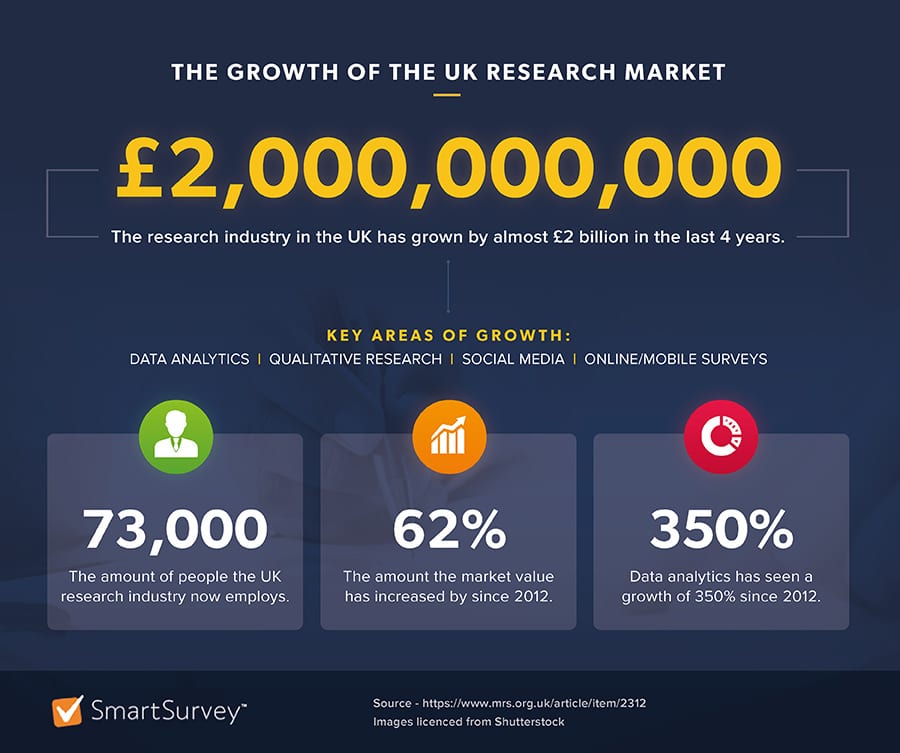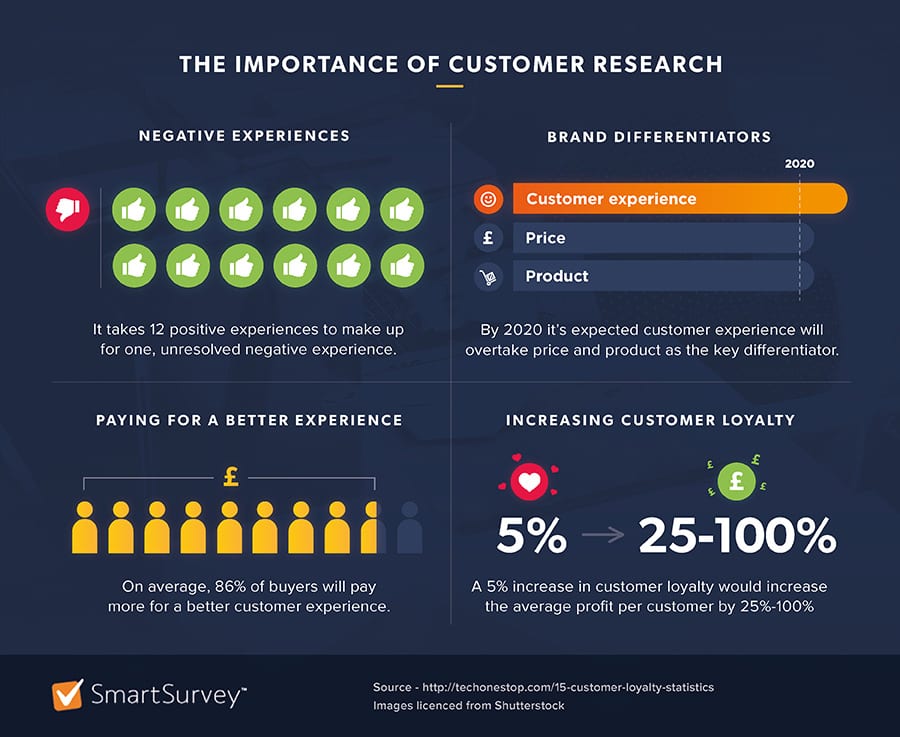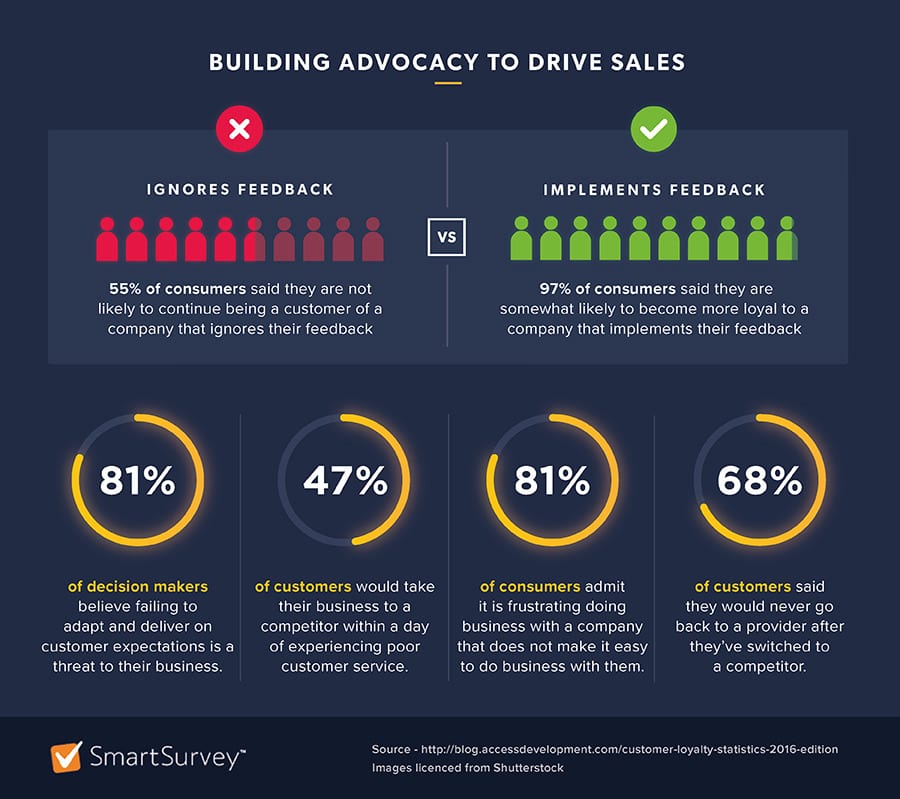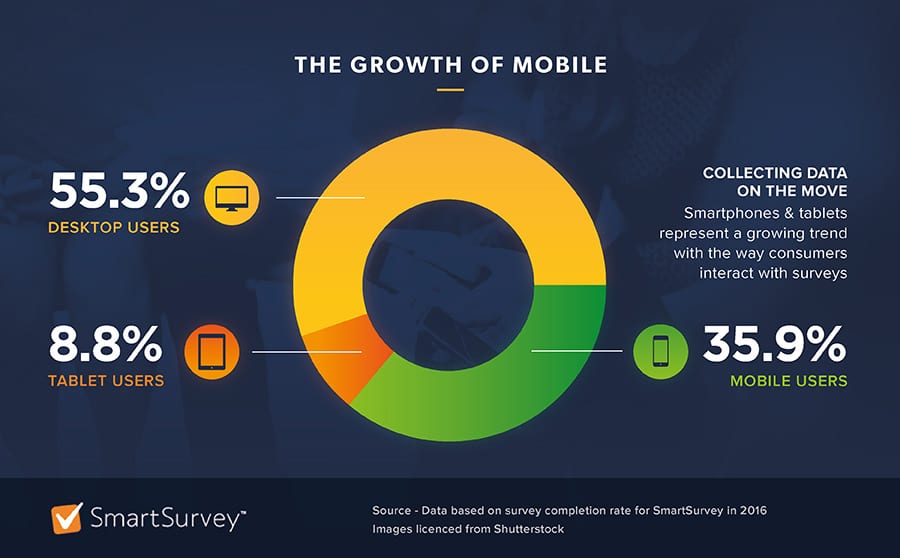Taking action with the collection and analysis of survey data to help improve the customer journey and strengthen company processes.
Data collected from online surveys can do so much more than tell you what your customers are thinking. Research is a vital addition to any B2B and B2C marketing toolkit. Successful companies are developing their business strategy - with the aid of data - to make marketing decisions that identify and resolve customer issues.
The team at SmartSurvey (the UK’s leading online survey provider) have put together a guide to demonstrate effective use of online questionnaires and how to utilise surveys to shape your marketing strategy.
Sections covered in this guide include:
- The Benefits of Collecting Customer Data
- How to Collect Reliable, Honest Feedback
- Designing Effective Online Surveys
The Market Research Society (MRS) recently published an article demonstrating that the UK research market has increased by 62% to £4.8 billion. A recent comprehensive sector review (The PWC report Business of Evidence 2016) shows the research industry in the UK has grown by almost £2 billion in the last 4 years and now employs 73,000 people. Its annual revenue exceeds that of the UK music industry and the public relations and communications sector.
Jane Frost CBE, CEO of MRS, commented in the review that “the incredible growth we have seen since 2012 is testament to the value that organisations place on the importance of evidence-based decisions. It reflects the increasing confidence and importance of research and its practitioners to decisions being made at every level across both the public and private sectors”.
This development is primarily due to an increase of data analytics and the amount of research being undertaken in-house by the private sector.
Key areas of growth include:
- Data analytics
- Qualitative research
- Social media & web traffic monitoring
- Online & mobile surveys
The top three business benefits of research and analytics, shown in PWC’s Infographic, are:
- Increased efficiency
- More confident decision making
- Cost savings
John Gambles, Chairman at Quadrangle Group commented, “In the second wave of digital, whoever can integrate research and data and turn this into value for clients has tremendous, unprecedented power. It is an enormously exciting period of change for our sector”.
So, to help you shape an effective marketing strategy by using research as a tool, we have compiled answers to some key questions marketers may be asking.
Section 1: The Benefits of Collecting Customer Data
What is the Importance of Collecting Customer Data?
Customers are spending increasingly more time online. They’re connecting with digital channels and are spending less time having human interactions. Marketing teams are capturing accurate metrics, however, they’re not using one-to-one communications that show their customers that they are listening and understanding their problems. This is why surveys are important: customer data can help to inform better practices in the future.
Admittedly, online surveys are sometimes subject to criticism, described as one-way conversations that gather data for the benefit of the survey maker and not the customer. However, surveys that are designed well are valuable because they can be used to nurture loyalty by building a sense of community, encouraging customers to return time and again.
It’s worth remembering, according to research carried out by Econsultancy, that 70% of companies say it’s cheaper to retain a customer than acquire one. Surveying your customers is a proven method of developing customer loyalty as customer feedback offers insight about what your customers are thinking.
The Benefits of First Party Data
Collecting first party data provides the richest, highest quality insights into consumer behaviour. Digital Strategy Consulting has provided research demonstrating first-party data is a marketers’ top choice for success across key metrics:
· 74% said it gives the greatest insight
· 64% said it offers the highest increase to customer lifetime value
· 62% said it provides the highest lift among data sources
82% of all marketers surveyed are planning to increase their use of first-party data, while 1 in 4 marketers plan to decrease their use of third party data according to MarketingTech.
Why is Customer Satisfaction important?
Ross Beard of Client Hearbeat explains that “any customers that give you a customer satisfaction rating of 7 and above (out of 10) can be considered satisfied and you can safely expect them to come back and make repeat purchases. Customers who give you a rating of 9 or 10 are your potential customer advocates. Scores of 6 or below in terms of customer satisfaction are in danger of leaving’. By constantly appraising customer feedback, a business can reach potential detractors, re-engage them and keep them as customers.
The Importance of Customer Loyalty
Businesses thrive on repeat customers. By maintaining and improving quality of products and levels of service, you will build loyalty to your brand.
The key benefits to fully utilising survey data is in its application. Gathering customer data without using it appropriately means it becomes a one-way conversation, or worse, serves very little purpose at all. Many digital marketers would agree that the use of website analytics and email reporting is redundant unless data is used to shape improvements. The same thinking should be applied to the survey process in order to enhance the marketing plan.
Why Does Analysis of Customer Data Benefit Your Business Strategy?
Businesses have many uses for survey data:
- Increasing Net Promoter Score: NPS is a simple and effective way to measure customer loyalty. A pre-set question type can be added to any online survey that you create. Results will allow management teams to make well-informed business decisions. Research by Marketing Week shows that Marketers who fail to address brand experience will see loyalty drop.
- Product development: Organisations must diversify and improve in order to grow. Developing your product range will help achieve business goals. A well planned product development strategy can help establish your company as an industry leader. By surveying existing consumers, you can validate a plan for entering new markets.
- Concept testing: By evaluating consumer response to product ideas with concept testing surveys, you can trial your ideas before bringing them to the market. This pro-active strategy can help save time and money across all marketing projects from designing ad campaigns to product launches.
- Employee engagement: Higher levels of employee engagement leads to increased productivity. By surveying your staff you can demonstrate that you understand their needs and act upon negative trends before they escalate.
Section 2: Ways to Collect Reliable, Honest, Actionable Data
Successful surveys are the key to understanding what your audience is thinking. The insight gained from an online survey can instantly empower a range of significant decisions.
Successful Surveys – Your 6 Point Guide
Online surveys are easy to create in a few simple steps, but some initial planning will aid you in collecting useful data that can help you achieve your objectives.
- State the objectives
- Select your audience
- Ask the right questions
- Distribute via the right channels
- Report results in real-time
- Identify key issues
Survey Distribution and Data Collection
As part of your survey strategy, think about how the survey is being received and completed. Are your respondents going to be in the office, at home or on the move?
The modern day consumer is very engaged with their smartphone. In fact, it has become the main device for mobile research and communicating directly with brands, businesses, and friends. Your mobile responsive survey can be delivered directly to smartphones and tablets, reaching audiences on the move.
What are the Challenges of Gathering Data?
The key challenge for the success of most surveys is making sure the questionnaire is accessible for your target audience.
Features that will help increase response rates are:
- Multi Language surveys: Create just one survey in as many different languages as you like. The benefit means that you can survey anyone in the world with the same questionnaire, giving them the choice of language at the outset. This should lead to increased response rates and more reliable results for analysis.
- Sending surveys via SMS: Reach a wider audience by catching users whilst they are on the move. Mobile Squared anticipates Smartphones in use to grow 63.5% to 4.48 billion users by end-2018. Sending survey invites via SMS allows you to reach potential respondents in the field, at the exact moment their opinion is formed.
- Offline surveys: Collect face-to-face feedback on your tablet or smartphone at the point of experience. This method allows you to gather the data you need anywhere, regardless of connectivity.
Section 3: Why Online Surveys Should be Part of Your Marketing Toolkit
Online surveys can provide an integral part of your research and measurement toolkit to help shape marketing strategy. Don’t think about sending surveys just to gather data on customer satisfaction, you can ask as much or as little as you want about any topic.
Features to Use When Planning Effective Online Surveys
Below we have highlighted 6 features available for building state-of-the-art surveys. All allow you to use online questionnaires to help you meet your marketing objectives.
- Automation: Send bulk email and SMS survey invitations, send reminders and easily manage contact lists. Check on the status of your invites, track open rates, views, failures and opt-outs.
- Security and compliance: Control access to any of your surveys by applying password protection and setting username/password security. Also, set passwords for your survey results in order to keep the private, private.
- Multi-language accessibility: Create surveys in any language, including those with right-to-left formatting, for use with worldwide audiences.
- Branding & design: Customise everything from the logo and background image to the fonts and question colours in order to build trust and loyalty to your brand.
- Accessibility & compatibility: Send surveys that are compatible with mobile devices, support different languages and integrate with your social media networks.
- Real-time reporting: Immediately use and act on the respondent data, testimonials, market data and satisfaction feedback you collect. As Sean Jackson explains in his post in Digital Marketing magazine, companies need to be able to analyse data in real-time. “By identifying relevant data quickly, companies can improve their competitiveness and the performance they deliver to customers”.
Conclusion
By instituting the strategy highlighted in this report, you can use online surveys to act on customer feedback to make informed decisions in all areas of your business. Use the information from the data collected to strengthen your customer offerings and improve company processes.
We hope this guide on the benefits and effective use of online surveys is useful - please share it and send us your feedback or questions.
source http://www.smartinsights.com/customer-engagement/customer-engagement-strategy/customer-data-shape-marketing-strategy/




 Thanks to Mo for sharing their advice and opinions in this post. Mo Naser is an industry expert in the field of online survey software. In his job as Sales & Marketing Director he introduces people and organisations to
Thanks to Mo for sharing their advice and opinions in this post. Mo Naser is an industry expert in the field of online survey software. In his job as Sales & Marketing Director he introduces people and organisations to
No comments:
Post a Comment